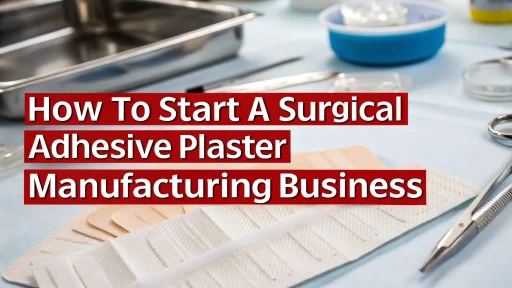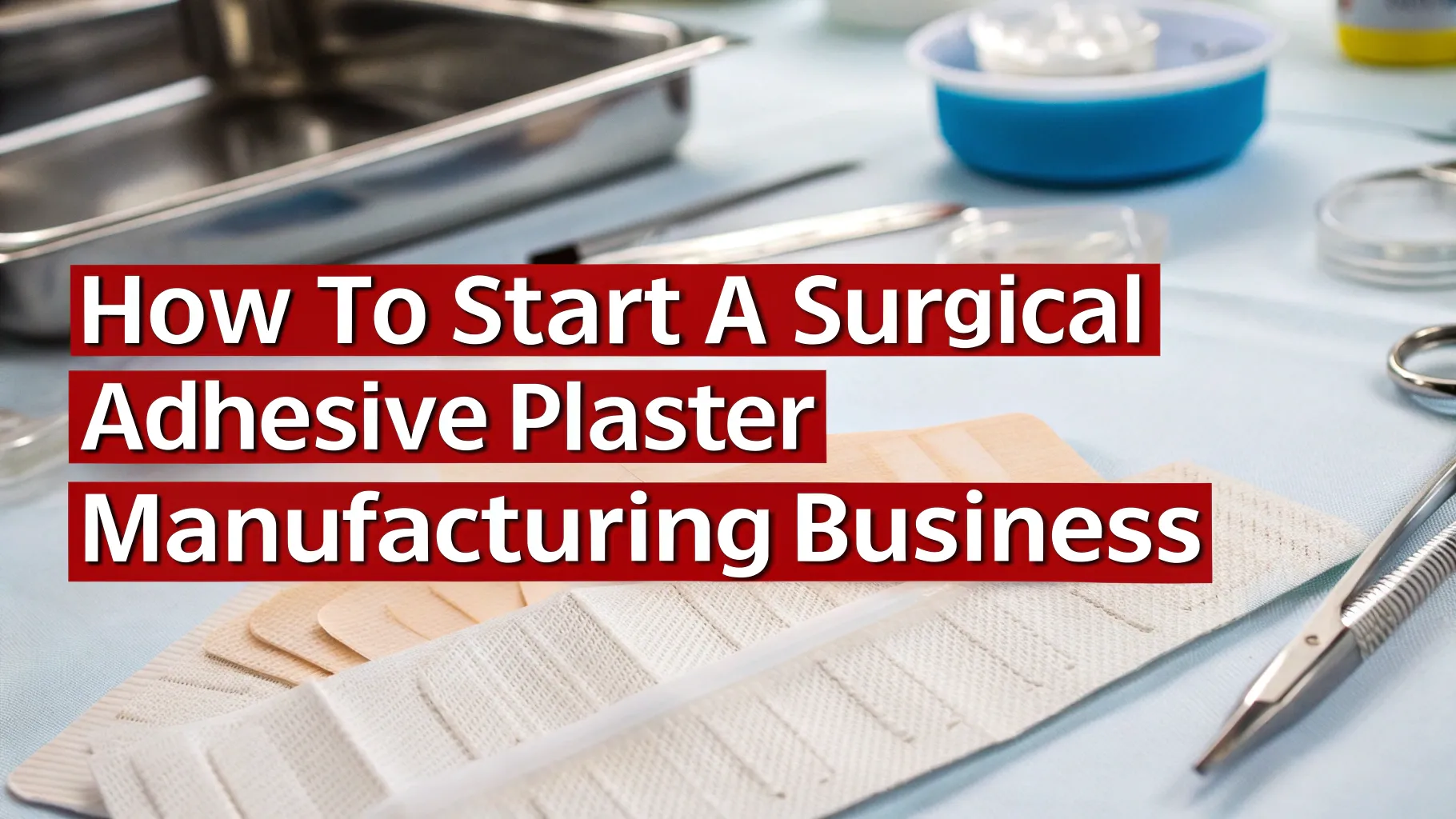The medical and healthcare supplies market in India is experiencing rapid change, fuelled by a growing demand for low-cost Surgical Adhesive Plaster as well as increased public awareness as well and the growth of medical infrastructure both in rural and urban settings. In the vast array of medical consumables, surgery adhesives are now an essential product that is used in hospitals, clinics, first-aid kits, as well as home health facilities. They are not just employed to shield wounds, but also to keep surgical catheters and dressings in place.
If you’re an entrepreneur looking to establish an industrial business that will provide constant demand, low complexity, and an expanding export as well as domestic market, the Surgical Adhesive Plaster are a great business opportunity. We’ll discuss the potential of business and market dynamics, the manufacturing process, regulatory requirements and the most important considerations to help you figure out the best way to begin manufacturing a surgical adhesive enterprise in India.
Understanding the Product: What Are Surgical Adhesive Plasters?
The surgical adhesive is a non-sterile and sterile medical device that are designed to protect minor injuries, cuts or surgical wounds. They usually consist of a soft covering substance (such like cotton or poly) and a pressure-sensitive adhesive as well as an absorbent pad in the middle of the. The adhesive allows the plaster to adhere to the skin. Meanwhile, the absorbent pad protects and cushioning for the wound.
The plasters are available in different varieties, such as strip bandages, roll plasters ,hypoallergenic or waterproof plasters and specialized versions like transdermal drug patches and sports tapes.
Their significance in medical procedures, emergency treatment and everyday healthcare makes them a common product in both retail and institutional environments.
Related: Start a Surgical Instruments Business in India
Why This Business is Worth Considering: Market Demand and Growth
Experts estimate that India’s medical supplies market is growing at over 7% annually and will reach USD 14–16 billion by 2028. In this market, surgical plasters have an important portion due to their huge volume of use in healthcare institutions as well as retail pharmacies. The increasing demand for first aid products, improved hygiene awareness and the accessibility to medical services in rural areas drive the demand of surgical plasters.
What makes this product appealing in a business sense is the fact that it has a constant demand. Hospitals as well as nursing homes, trauma centers, army camps, ambulances and first-aid boxes for households all require a continuous supply with these plasters. The government’s tenders for healthcare supplies and the increased use of private hospitals also boost market potential.
India is also an important hub for the export of medical disposables to developing countries across Asia, Africa, and the Middle East. They often purchase cost-effective surgical plasters made by Indian producers that meet international standards for quality and at affordable costs.
Setting Up a Surgical Adhesive Plaster Manufacturing Unit
The process of starting a manufacturing business requires knowing the technical specifications of the product and creating a clean and controlled production environment. The fundamental setup consists of the acquisition of raw materials, machinery as well as a skilled workforce. the compliance with health safety regulations.
The manufacturing process usually begins by selecting a high-quality backing material like cloth, PVC film, and non-woven fabrics. Technicians coat the backing fabric with medical-grade adhesive using laminating or coating machines. They then apply the adhesive layer to the absorbent pad and place it precisely at the center. Finally, they dry and set the sheet under controlled conditions to preserve the adhesive’s quality.
Automated slitting and packaging machines cut the material into various sizes and seal it. Operators then pack the product in either sterile or non-sterile packaging, depending on its final use. If required, they sterilize the product using Ethylene Oxide (ETO) gas or Gamma radiation.
A clean and safe environment in the production and packaging phases is a must. Since these products come into direct contact with wounds and skin of humans and wounds, even a minor contamination could cause serious problems.
Raw Materials Required
The primary raw materials that are required for this manufacturing unit comprise:
- Polyester fabric or plastic film non-woven materials as the basis
- Pressure-sensitive medical-grade adhesive
- Pad that absorbs (non-stick gauze, or even foam)
- Butter paper, or silicon release paper to pack products
- Sterile packaging films
- Cartons and labels for branding and transportation
All raw materials must be purchased from trusted suppliers that can provide medical-grade quality and guarantee that the product is consistent in its the performance.
Related: How to Start a Surgical Methylated Spirit Manufacturing Business?
Regulatory and Quality Standards
Since surgical plasters are in those of medical devices. companies in India must adhere to the Medical Device Rules, 2017 which are governed by the Central Drugs Standard Control Organization (CDSCO). In accordance with these rules adhesive plasters are classified as classified as Class A or medical devices of Class B based on their usage and risk factors.
To legally operate to operate legally, the manufacturer must get:
- Manufacturer Licenses from CDSCO
- Site Registration under the Drugs and Cosmetics Act
- ISO 13485 certification for quality management
- BIS standard (if appropriate)
The compliance with these rules does not just allow legal production, but also increases the appeal that the products are marketed, specifically for exports and hospital tenders. Conducting regular audits and quality checks are vital to ensure the safety and consistency of the product.
Plant Layout and Infrastructure
A well-planned layout of the plant is vital for a efficient operation and compliance with regulations. The plant must have separate zones for storage of raw materials drying and coating cutting, packaging and storage for finished goods. The building must be dust-free and ventilated with adequate ventilation, air filtration and a cleanroom facility if it produces sterilized products.
In addition, you’ll need areas for laboratories for quality control and offices as well as the disposal of waste. Manufacturers may need to use energy-efficient machines, ensure water supply for cleaning, and install an Effluent Treatment Plant (ETP), depending on the scale of production.
Distribution Channels and Branding
A lot of manufacturers offer their products under their own brands or are OEM suppliers for brands with established names. Participating in tenders for hospital procurement or supply chains for state governments could provide bulk orders with repeated orders.
The branding aspect is crucial when entering the retail market for consumers. Plasters that have additional advantages like skin-friendly or waterproofing, as well as colorful prints can help distinguish your brand. Collaboration with medical distributors and launching awareness campaigns in local medical camps or clinics can help build trust.
Opportunities in Export Markets
The potential for exports of Indian medical adhesives and plasters for surgical use is growing rapidly. Countries located in Africa, Southeast Asia, and the Middle East are seeking affordable and reliable medical equipment. If your equipment is certified and has CE certification and is compliant to the guidelines of WHO’s General Medical Products standards, then it will be more feasible to export your product and tap into international demand.
If you list your products on international B2B platforms, take part in medical expos or negotiating agreements with distributors for emerging markets, your business will gain international recognition. The government agencies like Pharmexcil aid exporters with aid and subsidies for trade fair participation.
Challenges to Anticipate
While the opportunities are promising but there are issues in this field. Maintaining consistent quality of products and ensuring the safety of microbial contamination and ensuring compliance with the regulatory documents need a keen eye. Additionally, because the marketplace is highly fierce, innovation in product design efficiency, efficiency of operations and the quality of the product become key differentiators.
Another issue is finding competent personnel with a solid understanding of the operation of cleanrooms and adhesive coating equipment. Training staff and the implementation of SOPs could help fill this issue.
For more information check out this video
Final Thoughts: A Smart Choice for Long-Term Manufacturing
The need for plasters that are Surgical Adhesive Plaster isn’t only steady but also growing due to India’s growing healthcare infrastructure, growing rural outreach, and global demand. With the proper planning, as well as quality control systems and strategies for marketing, entrepreneurs can tap into an extremely large market that can promise expansion and export opportunities.
With its low technical barriers and the steady demand for it, this manufacturing venture is an ideal chance for entrepreneurs who want to get into the health product sector.
Which business to start? How to choose a business idea?
How NPCS Can Help
Niir Project Consultancy Services (NPCS) offers Market Surveys and Detailed Techno-Economic Feasibility Studies for the Surgical Adhesive Plaster and other health manufacturing companies. These reports offer vital insights into manufacturing processes as well as raw material source as well as plant layout design as well as the financial viability. NPCS assists entrepreneurs in evaluating the possibility of industrial plant layouts and provides consulting services to help guide your idea from conception to implementation.







